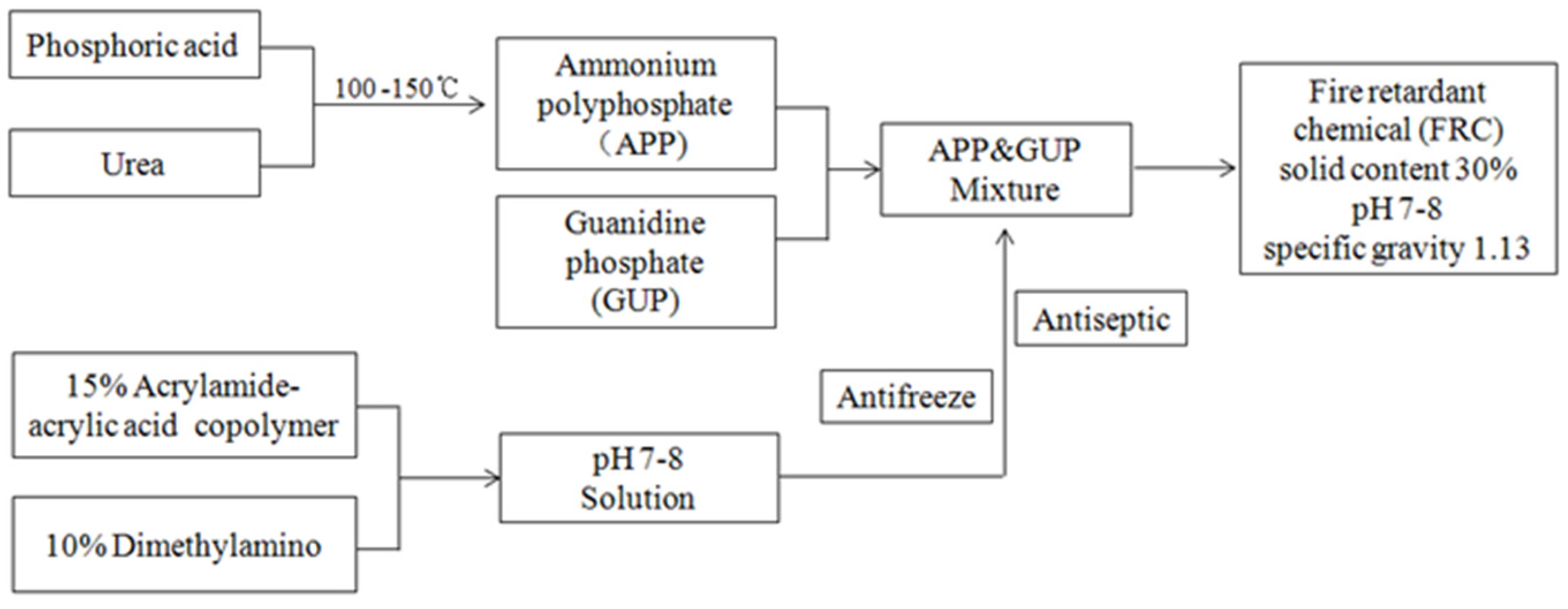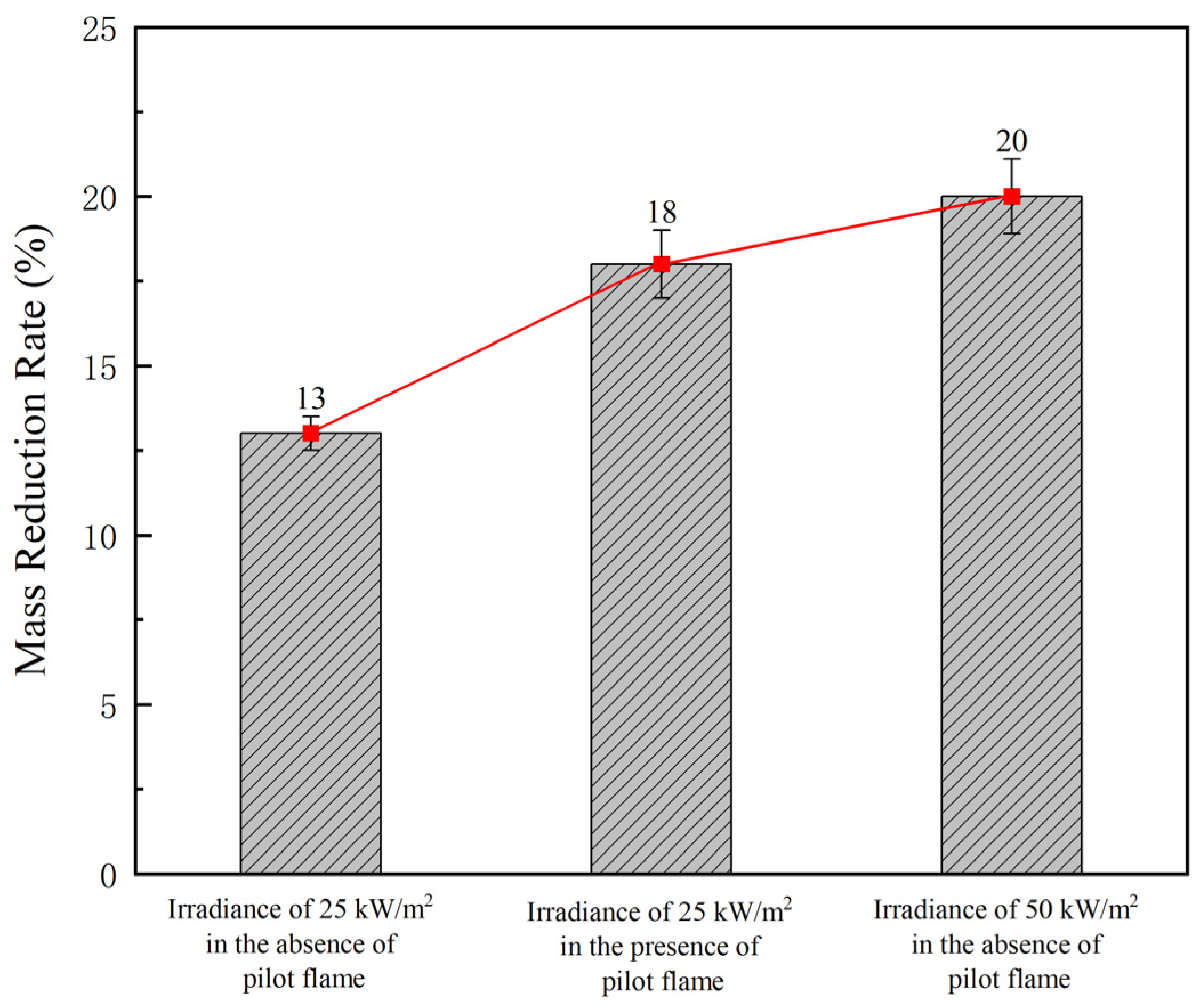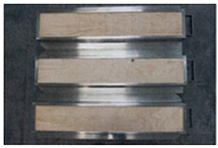Toxic Gas and Smoke Generation and Flammability of Flame-Retardant Plywood
Abstract
1. Introduction
2. Experiment and Methods
2.1. Testing Materials
2.1.1. Flame-Retardant Resin
2.1.2. Flame-Retardant Plywood
2.2. Test Methods
2.2.1. Test Equipment
2.2.2. Test Methods
3. Results and Discussion
3.1. Toxic Gas Generation
3.2. Smoke Generation
3.3. Flammability
4. Conclusions
- (1)
- As for the toxic gases generated during the combustion of flame-retardant plywood, among the eight kinds of toxic gases presented by the IMO, seven kinds other than CO were not detected. Even if CO was detected, its amounts did not exceed the thresholds under three test conditions. Therefore, unlike synthetic resin products, flame-retardant plywood was evaluated as a finishing material that can reduce the damage from toxic gases in the event of a fire.
- (2)
- In the smoke generation tests, the mass reduction rate showed a tendency to increase (13%, 18%, and 20%) as the test condition became more severe. In addition, the average Dm got higher (75.70, 81.00, and 191.20) under a more harsh condition but still met the standard of below 200 given by the IMO. This manifests that flame-retardant plywood is applicable as a finishing material.
- (3)
- The flammability of flame-retardant plywood was evaluated, and the values of CFE, Qt, and Qp were determined as 49.5 kW/m2, 0.21 MJ, and 0.66 kW, respectively, which were all within the acceptable ranges set by the IMO. Therefore, the applicability of flame-retardant plywood as a finishing material meets the fire safety standards.
- (4)
- The flame retardant characterization analysis verified that fire retardant chemicals with the APP, GUP, and phosphonic acid as main component treatments effectively accelerated the dehydration and carbonization of wood. Consequently, more char and less flammable volatile products resulted, and a better fire retardant performance was obtained.
- (5)
- This study provides evidence for the fact that fire-retardant wood and wood-based materials can also possess the capability against fire. These materials are expected to create buildings and residential environments that are safer from toxic gases generated by fire and minimize damage to humans.
Author Contributions
Funding
Data Availability Statement
Acknowledgments
Conflicts of Interest
References
- Popescu, C.M.; Pfriem, A. Treatments and modification to improve the reaction to fire of wood and wood based products—An overview. Fire Mater. 2020, 44, 100–111. [Google Scholar] [CrossRef]
- National Fire Agency. 2019 Fire Statistical Yearbook; National Fire Agency: Sejong, Republic of Korea, 2019.
- Liu, L.; Chen, T.B.Y.; Yuen, A.C.Y.; Doley, P.M.; Wang, C.; Lin, B.; Liang, J.; Yeoh, G.H. A systematic approach to formulate numerical kinetics for furnishing materials fire simulation with validation procedure using cone/FT-IR data. Heat Mass Transf. 2021; 1–19, prepublish. [Google Scholar] [CrossRef]
- Junod, T.L. Gaseous Emissions and Toxic Hazards Associated with Plastics in Fire Situation—A Literature Review; Nasa Technical Note, NASA TN D-8338; NASA: Washington, DC, USA, 1976. [Google Scholar]
- Kim, B.S.; Jang, B.J.; Choi, M.C. A Study on the Fire Safety Management Measures from During a Fire Toxic Gasea Generated (Focus to CO Gas Measures). In Proceedings of the Korea Safety Management & Science 2011 Autumn Conference, Cheonan city, Republic of Korea, 19 November 2011; pp. 55–66. [Google Scholar]
- Wei, W.; Yuntao, L. Prevention and Control Technology for Harmful Toxic Gas Intrusion in High-Fire-Hazard-Risk Areas of Close-Distance Coal Seams. J. Chem. 2020, 2020, 1–12. [Google Scholar]
- Wichmann, H.; Kolb, M.; Bulutcu, D.; Kolb, T.; Zehfuß, J. Analytical determination of compounds released during pyrolysis, smoldering, and combustion experiments with insulation materials from renewable resources. Fire Mater. 2022, 47, 3–15. [Google Scholar] [CrossRef]
- International Maritime Organization (IMO). IMO Resolution MSC. 307(88): ANNEX 1/Part 2. In International Code for Application of Fire Test Procedures; International Maritime Organization (IMO): London, UK, 2010. [Google Scholar]
- International Maritime Organization (IMO). IMO Resolution MSC. 307(88): ANNEX 1/Part 5. In International Code for Application of Fire Test Procedures; International Maritime Organization (IMO): London, UK, 2010. [Google Scholar]
- Building Officials Conference of America. The BOCA Basic Building Code, 5th ed.; Building Officials & Code Administrators International, Inc.: Chicago, IL, USA, 1970; 413p. [Google Scholar]
- Iben, H.; Richard, T.H. Flammability and burning behaviour of fire protected timber. Fire Saf. J. 2023, 140, 103918. [Google Scholar]
- Lee, J.W.; Lee, B.W.; Kwon, S.P.; Lee, B.H.; Kim, H.S.; Kim, H.J. Burning Behavior of Flooring Materials in the Cone Calorimeter and Evaluation of Toxic Smoke. J. Korean Wood Sci. Technol. 2008, 36, 45–53. [Google Scholar]
- Park, J.E.; Yoon, S.M.; Hwang, W.J.; Choi, Y.S.; Son, D.W. Gas Toxicity and ICP Analysis of Flame Retardant Wood. In Proceedings of the Korean Society of Wood Science and Technology 2019 Conference, Cheongju, Republic of Korea, 12–13 April 2019; p. 82. [Google Scholar]
- Park, H.J.; Wen, M.Y.; Cheon, S.H.; Kang, C.W.; Matsumura, J. Fire retardant performance and thermal degradation of Korean Pine treated with fire retardant chemical. J. Fac. Agr Kyushu Univ. 2015, 60, 183–189. [Google Scholar] [CrossRef]
- Wen, M.Y.; Kang, C.W.; Park, H.J. Impregnation and mechanical properties of three softwoods treated with a new fire retardant chemicals. J. Wood Sci. 2014, 60, 367–375. [Google Scholar] [CrossRef]
- Rasoulipour, S.; Fleischmann, C.; Mercieca, L.; Adams, N. Flammability of Engineered Wood Pyrolysis Gases at Anaerobic Condition. Fire Saf. J. 2021, 125, 103424. [Google Scholar] [CrossRef]
- KS F ISO 5660-1; Reaction to Fire Test—Heat Release, Smoke Production and Mass Loss Rate—Part 1: Heat Release Rate (Cone Calorimeter Method). ISO: Geneva, Switzerland, 2008.
- Fucheng, X.; Haiyang, Z.; Jianguo, W. Synergistic catalytic flame retardant effect of zirconium phosphate on the poplar plywood. Constr. Build. Mater. 2021, 290, 123208. [Google Scholar]
- Deng, C.; Liu, Y.; Jian, H.; Liang, Y.; Wen, M.; Shi, J.; Park, H. Study on the preparation of flame retardant plywood by intercalation of phosphorus and nitrogen flame retardants modified with Mg/Al-LDH. Constr. Build. Mater. 2023, 374, 130939. [Google Scholar] [CrossRef]
- Cui, M.; Li, J.; Qin, D.; Sun, J.; Chen, Y.; Xiang, J.; Yan, J.; Fan, H. Intumescent flame retardant behavior of triazine group and ammonium polyphosphate in waterborne polyurethane. Polym. Degrad. Stab. 2021, 183, 109439. [Google Scholar] [CrossRef]






| Construction | Uses | Toxic Gas and Smoke Generation | Flammability | Flame-Retardant Resin | ||
|---|---|---|---|---|---|---|
| Dimensions (mm) | Number of Specimens | Dimensions (mm) | Number of Specimens | |||
| Plywood | Bulkheads, Linings, Ceilings | W75 × L75 × T24 | 9 | W155 × L800 × T24 | 3 | NF200+ (SAMHWA PAINTS Industrial Co., Ltd.) |
| Procedure | Test Methods | |
|---|---|---|
| Toxic Gas Generation | Smoke Generation | |
| 1 | Remove all dirty layers and particles in the test chamber, and clean the internal probe. | Prepare the test chamber Prepare the test chamber with a cone set at 25 kW/m2 or 50 kW/m2, set the distance between the cone heater and the specimen to be 50 mm, and position the pilot burner 15 mm down from the bottom edge of the cone heater. |
| 2 | Maintain the filters, gas sampling line, valves, and gas cell at 150–180 °C for at least 10 min prior to test. | Tests with pilot flame For tests with a pilot flame, make the burner in position, turn on the gas and air supplies to ignite the burner, and check the flow rates. |
| 3 | During the smoke density test, start sampling by opening the sampling valve to introduce the gas in the chamber into the sampling line at the moment of maximum smoke density. | Preparation of photometric system Perform zero setting, open the shutter to set the full-scale 100% transmission reading, recheck the 100% setting, and repeat the operations until accurate zero and 100% readings are obtained on the amplifier and recorder when the shutters are opened and closed. |
| 4 | - | Loading the specimen Place the holder and specimen on the supporting framework below the radiator cone, remove the radiation shield from below the cone, and simultaneously start the data recording system and close the inlet vent. The test chamber door and the inlet vent must be closed immediately after the test starts. |
| 5 | - | Recording of light transmission Record the light transmission and time continuously from the start of the test. |
| 6 | - | Termination of test The initial test in each test condition must last for 20 min to verify the possible existence of a second minimum transmittance. |
| 7 | - | Conditioning of specimens Before measurement, the test specimens must be conditioned to a constant mass at 23 ± 2 °C and 50% ± 2% relative humidity. |
| Toxic Gas | Criterion (ppm) |
|---|---|
| CO | ≤1450 |
| HBr | ≤600 |
| HCl | ≤600 |
| HCN | ≤140 |
| HF | ≤600 |
| SO2 | ≤120 |
| NO | ≤350 |
| NO2 | ≤350 |
| Test and Condition | Before the Test | After the Test | |
|---|---|---|---|
| Toxic gas and smoke generation (IMO, Part 2) | Irradiance of 25 kW/m2 in the absence of pilot flame |  |  |
| Irradiance of 25 kW/m2 in the presence of pilot flame |  |  | |
| Irradiance of 50 kW/m2 in the absence of pilot flame |  |  | |
| Flammability (IMO, Part 5) | Heat flux: 50.5 kW/m2 (at the 50 mm position) 23.9 kW/m2 (at the 350 mm position) |  |  |
| Toxic Gas | Irradiance of 25 kW/m2 in the Absence of Pilot Flame | Irradiance of 25 kW/m2 in the Presence of Pilot Flame | Irradiance of 50 kW/m2 in the Absence of Pilot Flame | Criterion (ppm) |
|---|---|---|---|---|
| CO | 232 | 293 | 1444 | 1450 |
| HBr | 0 | 0 | 0 | 600 |
| HCl | 0 | 0 | 0 | 600 |
| HCN | 0 | 0 | 0 | 140 |
| HF | 0 | 0 | 0 | 600 |
| SO2 | 0 | 0 | 0 | 120 |
| NO | 0 | 0 | 0 | 350 |
| NO2 | 0 | 0 | 0 | 350 |
| Parameter | Irradiance of 25 kW/m2 in the Absence of Pilot Flame | Irradiance of 25 kW/m2 in the Presence of Pilot Flame | Irradiance of 50 kW/m2 in the Absence of Pilot Flame | Criterion |
|---|---|---|---|---|
| Initial mass (g) (±0.02) | 85.92 | 86.70 | 89.82 | Dm must not exceed 200 in any test condition |
| Final mass (g) (±0.02) | 74.38 | 71.02 | 71.49 | |
| Mass loss (g) (±0.02) | 11.53 | 15.68 | 18.33 | |
| Average Dm | 75.70 | 81.00 | 191.20 |
| Specimen 1 | Specimen 2 | Specimen 3 | Average | Surface Flammability Criterion 1 | ||
|---|---|---|---|---|---|---|
| Item | ||||||
| Average heat for sustained burning, Qsb (MJ/m2) | - | - | - | - | ≥1.50 | |
| Critical flux at extinguishment, CFE (kW/m2) | 49.5 | 49.5 | 49.5 | 49.5 | ≥20.0 | |
| Total heat release, Qt (MJ) | 0.30 | 0.16 | 0.17 | 0.21 | ≤0.70 | |
| Peak heat release rate, Qp (kW) | 0.87 | 0.53 | 0.58 | 0.66 | ≤4.00 | |
| Burning droplets | None | None | None | None | Not produced | |
Disclaimer/Publisher’s Note: The statements, opinions and data contained in all publications are solely those of the individual author(s) and contributor(s) and not of MDPI and/or the editor(s). MDPI and/or the editor(s) disclaim responsibility for any injury to people or property resulting from any ideas, methods, instructions or products referred to in the content. |
© 2024 by the authors. Licensee MDPI, Basel, Switzerland. This article is an open access article distributed under the terms and conditions of the Creative Commons Attribution (CC BY) license (https://creativecommons.org/licenses/by/4.0/).
Share and Cite
Park, H.-J.; Jian, H.; Wen, M.; Jo, S.-U. Toxic Gas and Smoke Generation and Flammability of Flame-Retardant Plywood. Polymers 2024, 16, 507. https://doi.org/10.3390/polym16040507
Park H-J, Jian H, Wen M, Jo S-U. Toxic Gas and Smoke Generation and Flammability of Flame-Retardant Plywood. Polymers. 2024; 16(4):507. https://doi.org/10.3390/polym16040507
Chicago/Turabian StylePark, Hee-Jun, Hao Jian, Mingyu Wen, and Seok-Un Jo. 2024. "Toxic Gas and Smoke Generation and Flammability of Flame-Retardant Plywood" Polymers 16, no. 4: 507. https://doi.org/10.3390/polym16040507
APA StylePark, H.-J., Jian, H., Wen, M., & Jo, S.-U. (2024). Toxic Gas and Smoke Generation and Flammability of Flame-Retardant Plywood. Polymers, 16(4), 507. https://doi.org/10.3390/polym16040507






